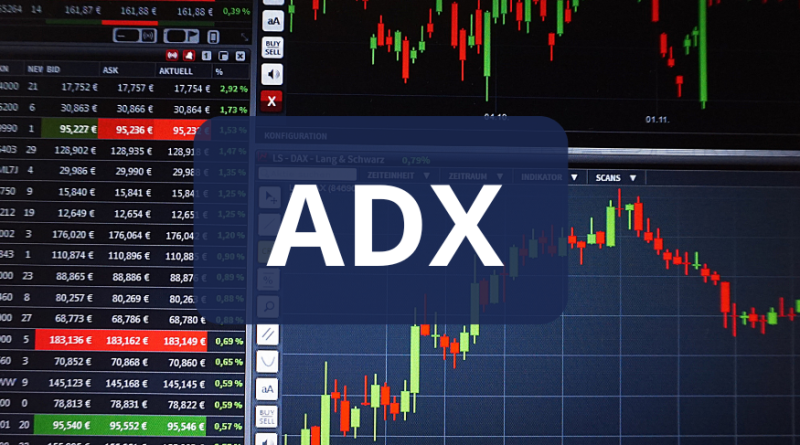Mastering the ADX indicator in trading
The Average Directional Index (ADX) is a technical analysis indicator developed by J. Welles Wilder Jr. to quantify the strength of a trend. It is a component of the Directional Movement System and is used to determine whether a market is trending or not.
The ADX is crucial for traders because it helps identify the strength of a trend, which is essential for making informed trading decisions. A strong trend often provides better trading opportunities compared to a weak or sideways market.
This article aims to provide a comprehensive guide on using the ADX Indicator effectively, covering its meaning, calculation, the best settings, platform-specific instructions, and practical trading strategies.
I. Understanding the ADX Indicator
Detailed Explanation of What the ADX Indicator Is:
The ADX Indicator measures the strength of a trend, regardless of its direction. It ranges from 0 to 100, where higher values indicate a stronger trend. Values above 25 typically suggest a strong trend, while values below 20 suggest a weak or non-existent trend.
Historical Context and Development by J. Welles Wilder Jr.:
The ADX was introduced by J. Welles Wilder Jr. in his 1978 book “New Concepts in Technical Trading Systems”. Wilder, a mechanical engineer turned technical analyst, developed several key indicators, but the ADX remains one of the most widely used.
Key Components:
ADX line:
The ADX line itself does not indicate the direction of the trend, only its strength. It is calculated based on the smoothed moving average of the absolute value of the difference between the +DI and -DI lines.
Plus directional indicator (+DI):
The +DI measures the strength of the upward movement in the price. It is calculated by comparing the current high to the previous high and indicating upward momentum when the current high exceeds the previous high.
Minus directional indicator (-DI):
The -DI measures the strength of the downward movement in the price. It is calculated by comparing the current low to the previous low and indicating downward momentum when the current low is lower than the previous low.
Understanding these components and their interactions is essential for effectively using the ADX Indicator in trading strategies. This section sets the foundation for deeper exploration into specific strategies and practical applications of the ADX Indicator in various trading platforms and markets.
II. ADX Indicator Formula
Mathematical Formula for the ADX Indicator:
The ADX is derived from the Moving Average of the Directional Movement Index (DMI). The steps to calculate the ADX are as follows:
- Calculate the Directional Movement (+DM and -DM) and True Range (TR) for each period.
- Smooth the values of +DM, -DM, and TR over the chosen period (typically 14).
- Calculate the Directional Indicators (+DI and -DI) by dividing the smoothed +DM and -DM by the smoothed TR.
- Compute the Directional Movement Index (DX) using the formula: 𝐷𝑋=∣+DI−-DI∣+DI+-DI×100DX=+DI+-DI∣+DI−-DI∣×100
- Smooth the DX values over the chosen period to get the ADX.
Importance of Each Component (DI+ and DI-) in the Calculation:
The +DI and -DI components are crucial as they provide the directional movement which the ADX uses to determine the strength of a trend. The difference between +DI and -DI and their relative values highlight whether the market is trending up or down.
Step-by-Step Example
Example calculation using a hypothetical dataset to illustrate how the ADX is computed:
Assume the following hypothetical data for a 14-day period:
-
- Calculate the True Range (TR), +DM, and -DM for each day.
- Smooth the TR, +DM, and -DM values.
- Determine the +DI and -DI.
- Compute the DX for each day and then smooth these values to get the ADX.
III. Best Settings for the ADX Indicator
Explanation of the Default Settings (14-Period ADX) and Why It Is Commonly Used:
The default setting for the ADX is 14 periods. This setting is commonly used because it provides a balanced view of the trend strength over a medium-term period, which is suitable for many trading strategies.
How to Adjust Settings for Different Trading Styles and Timeframes:
Day trading:
For shorter timeframes like day trading, a shorter period (e.g., 7 or 10) might be used to make the ADX more responsive to recent price changes.
Swing trading:
For longer timeframes like swing trading, a longer period (e.g., 20 or 30) can be used to smooth out the indicator and focus on more significant trends.
Impact of Varying the Period Length on the Indicator’s Sensitivity:
Shorter periods make the ADX more sensitive and quicker to react to price changes, but they can also generate more false signals. Longer periods make the ADX less sensitive, focusing on more substantial and sustained trends, reducing the number of false signals but potentially missing early trend changes.
IV. Using the ADX Indicator on Trading Platforms
How to Set Up and Configure the ADX Indicator on MetaTrader 4:
-
- Open MT4, navigate to “Insert” > “Indicators” > “Trend” > “Average Directional Movement Index.”
- Adjust the period settings and colors according to your preference.
Tips for Interpreting ADX Signals on MT4:
-
- An ADX value above 25 indicates a strong trend.
- Use the +DI and -DI crossovers to confirm trade entries.
ADX Indicator on TradingView
Steps to add and customize the ADX Indicator on TradingView:
-
- Open TradingView, go to the chart, and click on “Indicators” > “Built-ins” > “Average Directional Index.”
- Customize the settings and appearance to match your trading strategy.
Utilizing TradingView’s features to enhance ADX analysis:
-
- Use alerts for ADX crossovers and specific value thresholds.
- Combine ADX with other indicators for comprehensive analysis.
V. ADX Indicator Trading Strategies
Identifying Trend Strength
How the ADX indicator helps in determining the strength of a trend:
The ADX indicates trend strength; values above 25 suggest strong trends, while values below 20 indicate weak trends or sideways markets.
Recognizing trending vs. Non-trending markets:
Use the ADX to identify whether the market is trending (ADX > 25) or ranging (ADX < 20).
Trading with ADX
Strategies for using ADX to enter and exit trades:
Entry: Enter trades when ADX is above 25 and +DI crosses above -DI for buy signals (or -DI crosses above +DI for sell signals).
Exit: Exit trades when ADX begins to decline from high values, indicating a weakening trend.
Combining ADX with other indicators:
Moving averages: Use moving averages to confirm the direction of the trend.
RSI: Use the Relative Strength Index to identify overbought or oversold conditions in conjunction with ADX.
ADX Indicator Range
Understanding the ADX range values and their implications:
Below 20: Indicates a weak trend or sideways market.
20-25: Indicates potential trend development.
Above 25: Indicates a strong trend.
Above 40: Indicates a very strong trend.
By following this structured approach, traders can effectively utilize the ADX Indicator to enhance their trading strategies, identify trend strengths, and make informed trading decisions.
Conclusion
Recap of the Importance and Functionality of the ADX Indicator in Trading:
The ADX (Average Directional Index) indicator is a powerful tool that helps traders identify and measure the strength of a trend. By analyzing the ADX line along with the Plus Directional Indicator (+DI) and Minus Directional Indicator (-DI), traders can determine whether a market is trending and the intensity of that trend. This information is crucial for developing effective trading strategies, as it allows traders to enter trades during strong trends and avoid periods of low volatility. The ADX indicator’s ability to distinguish between trending and non-trending markets makes it an invaluable component of technical analysis.
Encouragement to Practice and Refine ADX-Based Strategies:
To maximize the benefits of the ADX indicator, it is essential for traders to practice using it in a demo account. This practice helps build confidence and allows traders to refine their strategies without the risk of losing real money. By experimenting with different settings and combining the ADX with other indicators, traders can develop a robust trading plan tailored to their specific needs and market conditions.
Emphasis on Combining Technical Analysis with Sound Risk Management:
While the ADX indicator is a valuable tool, it is crucial to integrate it with other technical indicators and sound risk management practices. Proper risk management ensures that traders can protect their capital and stay in the market for the long term. Combining ADX signals with tools like moving averages, RSI, or Bollinger Bands can provide additional confirmation and improve the accuracy of trading decisions.
References
Books:
“New Concepts in Technical Trading Systems” by J. Welles Wilder Jr. – A foundational text that introduces the ADX indicator and other key technical analysis tools.
“Technical Analysis of the Financial Markets” by John Murphy – A comprehensive guide covering various technical indicators, including the ADX.
“Trading for a Living” by Dr. Alexander Elder – Offers insights into trading psychology, technical analysis, and risk management.

